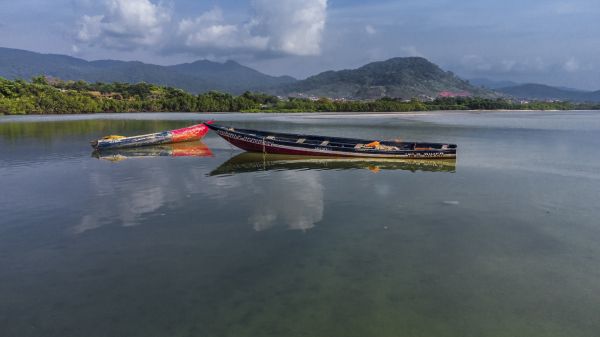Environmental Leadership Model for a Just and Sustainable Future

Written by Bashiru Koroma. NAAEE had the honor of hosting Bashiru for a virtual alumni professional development experience through the Mandela Washington Fellowship program.
From excruciating poverty, disease outbreaks, conflicts, growing inequality, and climate injustice, to environmental disasters, there is so much at stake for people and nature in our local communities, societies, nations, and world at large. It is impossible for aspiring leaders to ignore. Many of these environmental injustices and social challenges facing communities around the world, however, also serve as clear indicators of historical leadership failures. The challenges our people and planet are faced with today are beyond the reach of existing leadership approaches and styles for a sustainable and just future. They require unprecedented models such as radical collaboration among different members of society including children, youth, women, aged, rich, poor, and physically challenged, and across sectors and organizations.
I grew up in Mattru Jong, Bonthe District, in Southern Sierra Leone on the bank of the beautiful Jong River. When I was a boy in the early 1990s, the river ran pure for drinking, swimming, fishing, laundering, and other domestic uses. Its banks were forested with rich biodiversity including giant trees and different species of birds, primates, and other large mammals. Today, due to anthropogenic activities such as unregulated mining, the river is not only dirty and impure for human consumption, but it has also been contaminated and poisoned to the point that my two precious kids (Albashirr and Albashiratu) are no longer able to swim, fish, or launder there anymore as I did when I was a kid about 25 years ago. Despite Bonthe District having one of the world’s largest deposits of titanium ore (rutile) in the world with mining operations dating back to the 1960s, the district’s communities lack access to electricity, running water, good roads, good health services, and quality education.
Sierra Leone, like other coastal nations across the world, is bracing for more expected flooding every rainy season in addition to other environmental catastrophes. Sierra Leoneans were also recently cautioned by the Sierra Leone Meteorological Agency over an alarming increase in temperature across the country, surpassing normal ranges for this time of the year. The majority of the Sierra Leonean population is inadequately equipped to deal with this crisis, and considering the magnitude and scale of these challenges, most people are afraid of the future and are wondering what they can do individually and collectively to create a liveable planet.
From the international to community level, our institutions, policies, conventions, treaties, by-laws, regulations, acts of parliaments, and conferences continuously fail to make environmental leadership decisions that work for a just and sustainable planet. This is the result of the fact that our planet and its ecosystems which support our health and prosperity lack a single leader, executive, team, or coordinated effort responsible for sustainably maintaining our air, land, oceans, forests, rivers, grasslands, farms, etc. This calls for adopting a leadership model that is inclusive, diverse, broadbased, and transformational, and that considers personal choices, business decisions, national laws, and international commitments.
From mentor programs, fellowships, and leadership institutes that have taken me across the world, I have learned about different leadership models and their implications for a just and sustainable planet [Learn more about Bashiru’s background here]. Such models include:
- The Adaptive Conservation Leadership Model was introduced by Ronald Heifetz and Marty Linsky in the book ‘’Leadership on the Line’’. The Adaptive Leadership model emphasizes a leader's willingness to challenge and engage people, promote their resourcefulness, and help them adjust to new realities .I learned about this model through the United States Fish and Wildlife Service (USFWS) sponsored Mentor Program (MENTOR-PACE) at Njala University
- The V3 Leadership Model is tailored for African leadership, delves into an in depth application of Virtue, Value and Vision to prepare aspiring leaders to lead with integrity, inspire with value, and steer with a visionary outlook. This model was adopted from the African Leadership University School of Business through the Conservation Master of Business Administration from 2020 to 2022.
- The Strengths-Based Leadership and Servant Leadership Models are built on the belief that the most effective leaders strive to serve others and give back to their community by capitalizing on their strengths. They recommend that leaders should freely and frequently commit their time and expertise to the needs of others by promoting inclusion and innovation in their communities. This model was presented at the Mario Einaudi Center for International Studies and Jeb E. Brooks School of Public Policy at Cornell University through the Leadership in Public Management of the Mandela Washington Fellowship for Young African Leaders in 2023.
Combining these leadership models and theories with over a decade of practical experience serving in conservation leadership and natural resource management at the community, regional, national, and global level, I have a firm conviction that our world needs to reimagine what type of leadership will present a positive reality for our people and planet.
Our planet is in dire need of a collective transformational, strengths-based leadership model for a just and sustainable future. We need broad-based and inclusive leadership practices that will bring together every aspect of our society to take collective action in addressing the climate crisis, poverty, disease outbreaks, environmental disasters, and other challenges. We require leadership that supports successful collaboration and networking with indigenous and marginalized groups to take local climate actions to permanently protect their lands, air, water, forests, and cultures.
In my Professional Development Experience with the NAAEE, I have learned about ways to grow this type of leadership required to address environmental and social issues through programs such as NAAEE’s CEE-Change Fellowship and the GEEP’s EE 30 Under 30.
Moving forward, I will be collaborating with NAAEE to explore replicating these programs in Sierra Leone and West Africa to support leadership and innovation in civic and environmental education. I will be exploring new partnerships and networks to aid in the founding of an academy to empower, build the capacity, and inspire youth, women, and other marginalized groups in my community to become the leaders our world needs.
